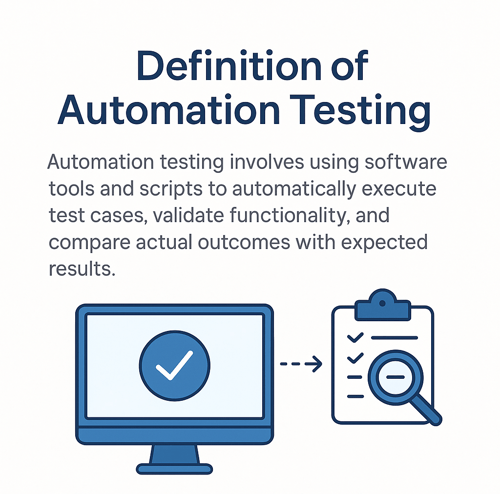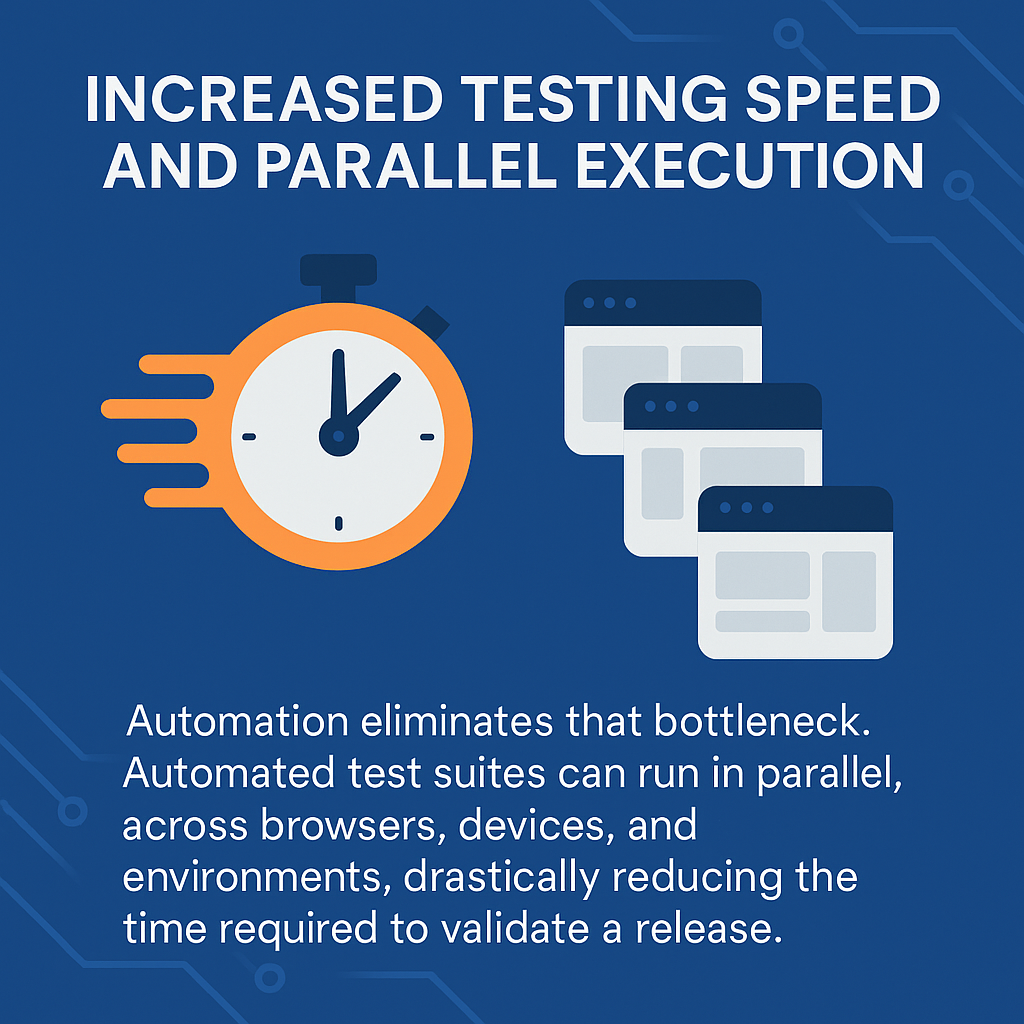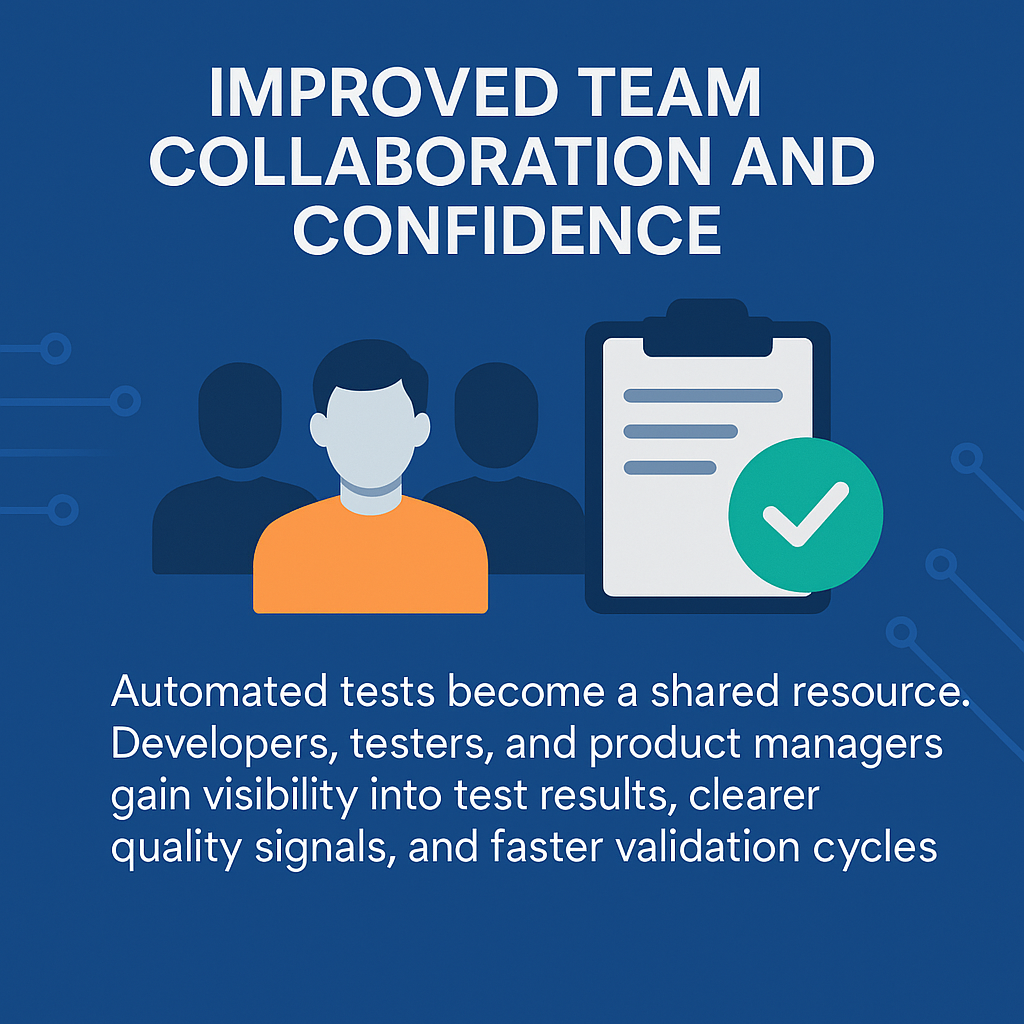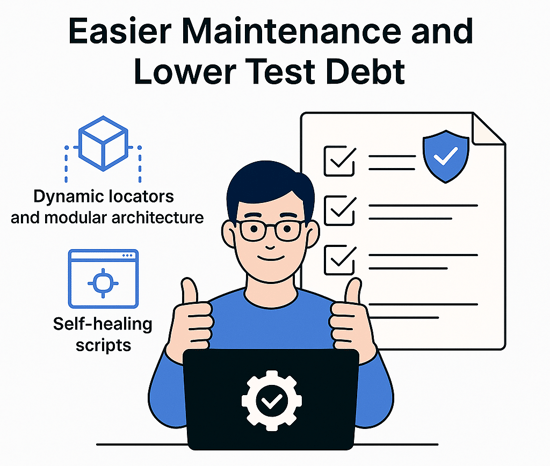17 Key Advantages of Automation Testing for Modern Businesses
Author: The MuukTest Team
Published: January 5, 2023

Table of Contents
How can we ship faster without increasing risk? Where are we losing time and resources in QA? How do we scale testing without scaling headcount? These are the challenges today’s engineering leaders face every day.
Automation testing addresses them head-on. It reduces costs, speeds up feedback, improves test coverage, and supports continuous delivery. For teams managing complex systems under tight timelines, it's no longer optional.
In this guide, we cover the 17 most impactful advantages of automation testing, backed by real examples from MuukTest customers. Whether you're exploring automation or scaling your current setup, this is a practical look at how automated testing can improve performance, productivity, and product quality.
Key Insights
-
Automation unlocks scale: It allows teams to test more, in less time, with fewer resources.
-
The most significant ROI comes from consistency and speed: Faster feedback, fewer regressions, and more confident deployments add up quickly.
-
Coverage is power: Broad, repeatable testing across devices and environments helps surface issues before users ever see them.
-
QA can be proactive, not reactive: When automation handles the repetitive work, QA teams shift their focus to high-value, strategic testing.
Definition of Automation Testing

Automation testing involves using software tools and scripts to automatically execute test cases, validate functionality, and compare actual outcomes with expected results. Unlike manual testing, which requires human input to run each test step, automation allows teams to test faster, more frequently, and at scale.
In the context of the software development lifecycle (SDLC), automation testing plays a critical role in reducing feedback loops, catching regressions early, and enabling continuous delivery. For fast-moving teams, it’s one of the most effective ways to build quality into the development process from day one.
Manual vs. Automated Testing (at a glance)
| Manual Testing | Automation Testing |
|---|---|
| Time-consuming and repetitive | Fast, repeatable, and scalable |
| Prone to human error | Highly consistent and reliable |
| Limited test coverage | Broad, parallel test coverage |
| Slower feedback for developers | Instant feedback in CI/CD pipelines |
While manual testing still has a place for usability and exploratory testing, the advantages of automation testing — including speed, accuracy, and cost savings — make it essential for any modern QA strategy. Teams adopting automation are seeing measurable improvements in release velocity, defect detection, and engineering efficiency.
17 Key Benefits of Automation Testing
With the fundamentals in place, let’s break down the 18 key advantages of automation testing. These benefits are grouped and ordered by their impact on business outcomes.
1. Cost Savings and ROI
For CTOs, every investment must deliver measurable business value, and test automation is one of the highest-ROI moves a tech team can make.
Manual testing consumes valuable engineering hours and grows linearly with your product. Every new feature, integration, or environment means more tests, more time, and higher costs. Automation breaks that cycle. Once your tests are written, they can run 24/7 in parallel across platforms with no additional headcount.
This reduces time spent on regressions, accelerates releases, and minimizes revenue lost to bugs in production.

Example: Spiffy, a rapidly growing mobile car care service, faced challenges in scaling its quality assurance (QA) processes to keep pace with its expansion. By implementing 251 automated tests with MuukTest in just 90 days, they identified 20 hidden defects early in the development cycle. This proactive approach not only improved product quality but also reduced the need for extensive manual testing, leading to substantial cost savings.
Key ROI Drivers of Automation Testing:
-
Fewer bugs in production = fewer fire drills and less rework
-
Faster releases = faster time to value for new features
-
Lower manual QA burden = reduced long-term staffing costs
Teams that adopt automation earlier realize cost efficiencies that compound with every sprint.
2. Faster Feedback Loops for Developers
One of the most valuable benefits of automation testing is its ability to accelerate feedback across development cycles. With automated tests integrated into your CI/CD pipeline, teams are notified of failures within minutes of a code commit, not hours or days later.
This speed enables rapid iteration, reduces bottlenecks, and helps teams ship more frequently with fewer surprises. Faster feedback means fewer context switches for developers and quicker resolution of defects while the code is still fresh.
Real-world result: Slope, an actuarial modeling platform, cut its test execution time from half a day to just 75 minutes using MuukTest. This enabled their team to release confidently without slowing development down, directly improving delivery velocity.
3. Fewer Bugs in Production (Improved Product Quality)
Automated tests reduce the risk of defects making it into production by continuously and consistently validating functionality. By catching issues earlier, ideally before code even reaches staging, teams avoid costly hotfixes, rushed QA cycles, and user-facing bugs.
Over time, this leads to more stable releases, fewer interruptions, and a better customer experience.
Example: In the early months of working with MuukTest, Pienso identified 28 previously undetected bugs through automated test design and execution. These were issues the team hadn’t known existed, and would have likely been caught by users in production.
"MuukTest found things that we didn't know were even a problem in the product, which is huge for us. I'd rather MuukTest find something than a customer, even if it's minor."
Wendy Murry
COO | Pienso
4. Increased Test Coverage Across Devices and Environments

Manual testing is limited, not just in the number of test cases you can execute, but also in the number of environments you can realistically test. Automation removes both constraints. It allows teams to test more workflows, in more places, with less effort.
Automated tests can be run across multiple browsers, devices, operating systems, and configurations in parallel. This expanded coverage helps teams identify issues that would otherwise go undetected, particularly in cross-platform or multi-user scenarios. It reduces blind spots and gives you greater confidence in how your product performs in the real world.
Example: GrowerIQ, a cannabis compliance platform, used MuukTest to automate complex workflows that included thousands of test steps across varied environments. This allowed their small team to dramatically expand test coverage nd surface edge-case defects early without slowing down their release cycles or scaling their QA headcount.
5. Faster, Safer Releases (Reduced Deployment Risk and Time-to-Market)
One of the most apparent advantages of automation testing is its impact on release velocity. With a reliable suite of automated tests, teams can deploy confidently, knowing that key user flows, backend systems, and business logic have been validated.
Automated checks serve as a safety net, catching regressions, failed integrations, or unexpected behavior before the product is released to users. This means fewer rollbacks, fewer hotfixes, and less stress on release day.
Real-world result: Slope, a financial modeling platform, saw a significant improvement in its release process after working with MuukTest. With test execution time cut down to 75 minutes and regressions covered automatically, the team could move faster and deploy with fewer risks.
Automation turns releases from an anxious moment into a regular part of your workflow, fast, stable, and drama-free.
6. Reduced Manual Workload
As products scale, the manual effort required to test each release increases. Without automation, QA teams spend a large portion of their time on repetitive tasks like regression, smoke, and cross-browser testing — time that could be spent on exploratory testing or product improvements.
Automation offloads that repetitive work. It allows teams to do more with fewer resources, while ensuring critical tests are never skipped due to time constraints. This makes it easier to scale testing efforts without increasing the size of the QA team.
For example, Counter Tools, a nonprofit organization, saved over 40 hours of manual testing each week after partnering with MuukTest. The time saved was reinvested into strategic development work, directly contributing to faster delivery and greater organizational impact, without increasing QA costs.
7. Time and Resource Efficiency
Test automation significantly reduces the manual effort required to execute repetitive test cases, especially in areas such as regression testing, smoke testing, and cross-browser validation. The result isn’t just faster execution, but more focused teams.
When QA engineers and developers no longer need to spend hours re-running the same tests every sprint, they gain time to focus on higher-value work, such as exploratory testing, edge case analysis, tool improvements, or supporting critical releases. Automation removes the grind from quality assurance, creating space for strategic contributions that drive real progress.
This benefit compounds quickly. What starts as a few hours saved per day becomes multiple days of strategic work throughout a release cycle. For growing teams, this added bandwidth can make the difference between maintaining velocity and falling behind.
8. Increased Testing Speed and Parallel Execution
Manual testing is sequential by nature. It’s limited by the number of people and the available hours. Automation eliminates that bottleneck. Automated test suites can run in parallel, across browsers, devices, and environments, drastically reducing the time required to validate a release.
This is especially valuable in fast-moving teams that push code frequently. What used to take hours (or even days) to verify manually can be executed in minutes. Faster testing means faster feedback, shorter sprint cycles, and the ability to catch issues without delaying delivery.
In high-velocity development environments, testing speed is critical. Automation ensures that QA keeps pace with product and engineering, not the other way around.

9. More Consistent and Reliable Testing (Reduced Human Error)
Manual testing is prone to variation. Different testers may interpret steps differently, skip procedures under pressure, or make mistakes, especially when working under tight deadlines or large regression suites. Automation removes that variability by executing tests the same way, every time.
This consistency is especially valuable when validating critical paths, such as logins, payments, or backend integrations. It ensures that key workflows are tested thoroughly and repeatedly without fatigue or oversight. And when something breaks, the failure is easier to reproduce and debug, because the test conditions are stable and repeatable.
Over time, reliable test execution builds trust in your QA process and confidence in every release.
10. Continuous Testing Through CI/CD Integration (Shift-Left Quality)
For teams practicing Agile or DevOps, testing can’t be a separate phase. It needs to happen continuously and automatically. By integrating automated tests into your CI/CD pipeline, every code change triggers immediate feedback, which reduces risk and speeds up delivery.
This approach supports the shift-left mindset: catching issues early, shortening feedback loops, and enabling frequent, safe releases. It also eliminates last-minute QA bottlenecks and keeps quality aligned with development speed.
Continuous testing isn’t just a best practice; it’s a requirement for teams that want to move fast without sacrificing reliability.
11. Better Use of QA Resources
Automation testing doesn’t eliminate the need for QA; it unlocks their potential. By handling repetitive test cases, automation frees QA professionals to focus on tasks that require critical thinking, creativity, and context, such as exploratory testing, edge-case analysis, usability assessments, and strategic planning.
This shift not only improves the quality of testing but also enhances team morale. Testers spend less time repeating workflows and more time uncovering real risks, supporting product innovation, and driving quality upstream.
When QA is no longer stuck in the loop of rerunning test cases, they can contribute where it matters most, preventing bugs, not just detecting them.
12. Improved Team Collaboration and Confidence
When tests are automated, version-controlled, and integrated into the development workflow, they become a shared resource, not just a QA task. Developers, testers, and product managers all benefit from greater visibility into test results, clearer quality signals, and faster validation cycles.
This shared understanding improves cross-functional alignment. Developers get immediate feedback when something breaks. QA can proactively flag issues before they become blockers. Product teams can track release readiness in real time.
More importantly, it builds confidence. When tests are reliable and always running, teams stop guessing whether something works; they know it does. When teams are confident in their test infrastructure, they move faster and make better decisions, without fear of breaking things.

13. Easier Scalability of QA Processes
As products evolve and teams grow, QA must scale with them. Manual testing doesn’t scale well; it requires more people and more time with each new feature or supported environment. Automation, on the other hand, enables QA to scale without significantly increasing overhead.
You can add new test cases, environments, or workflows without a linear increase in cost or effort. This is especially valuable for fast-growing teams or companies expanding across multiple platforms (e.g., web, mobile, multi-region).
Example: GrowerIQ used MuukTest to automate end-to-end testing for complex workflows that involve thousands of test steps. As their platform expanded to serve more users and regions, automation allowed them to scale QA coverage in lockstep, without expanding the QA team.
Scalability isn’t just a tech issue. It’s a leadership priority — and automation makes it achievable without breaking the budget or the team.
14. Better Reporting and Visibility for Decision-Making
Automated testing generates rich, consistent data — from pass/fail results to performance metrics and failure logs. When paired with visual dashboards or integrations, this data becomes a powerful tool for engineering and product leaders.
Instead of relying on anecdotal feedback or waiting for manual status updates, teams can track test coverage, stability trends, and release readiness in real time. This improves planning, speeds up triage, and helps leaders prioritize issues based on actual impact.
Example: SymTrain, an AI-powered training platform, achieved 100% QA coverage in just 90 days with MuukTest. Automation didn’t just improve their coverage, it gave them the reporting insights they needed to make faster, better-informed release decisions.
Reliable data makes quality measurable, and measurable quality leads to better execution.
15. Automated Regression Testing
Regression testing ensures that existing functionality still works after code changes, but running complete regression suites manually is time-consuming and often skipped when deadlines are tight. Automation solves this by making regression tests fast, repeatable, and easy to schedule with every build.
This not only protects against unintended side effects but also enables teams to release more frequently without sacrificing product stability. It’s one of the most common and high-leverage use cases for test automation.
With automated regression testing in place, QA becomes proactive instead of reactive, catching issues before they cause trouble, not after.
16. Easier Maintenance and Lower Test Debt
Test automation is often criticized for being hard to maintain, but with the right tools and test design strategy, automated suites can remain stable and scalable over time. Modern platforms like MuukTest support dynamic locators, modular test architecture, and self-healing scripts that adapt to minor UI changes.
This reduces the time spent fixing broken tests and lowers the ongoing maintenance burden. Instead of chasing false positives or brittle scripts, teams can focus on adding new coverage and refining tests as the product grows.
Low-maintenance automation preserves productivity and prevents test debt from building up and slowing teams down over time.

17. Reduced Risk and Stronger QA Governance
Every release carries risk, but automation dramatically lowers it. By ensuring that tests are run consistently, early, and often, automation reduces the chance of introducing defects that impact customers, compliance, or business continuity.
It also improves traceability and auditability. Test results are logged, version-controlled, and easy to report, helping teams meet both internal standards and external compliance requirements. For organizations operating in regulated industries, this kind of structured QA governance isn’t optional; it’s critical.
Automation turns testing from a manual task into a system of record. It brings structure, visibility, and accountability to your quality process.
Common Challenges of Automation Testing
While the advantages of automation testing are clear, implementing and scaling automation come with their own set of challenges. Many teams underestimate the complexity involved, which can lead to stalled efforts, high maintenance, or unreliable test suites.
Here are some of the most common hurdles:
-
High initial setup time and cost
Building a reliable automation framework from scratch requires planning, tooling expertise, and upfront investment. -
Flaky tests and false positives
Poorly designed tests often fail for reasons unrelated to the application, which erodes trust in the test results. -
Test maintenance overhead
As the product evolves, test scripts can quickly become outdated or brittle, leading to constant rework. -
Lack of skilled automation engineers
Not every QA team has access to team members who can build and maintain a robust automation architecture. -
Difficulty integrating with CI/CD pipelines
Tests that aren't designed to work with build pipelines often introduce friction instead of streamlining the delivery process. -
Limited coverage due to time or tool limitations
Teams may automate the easy tasks and overlook the complex, high-risk scenarios that truly require coverage. -
Misalignment with agile workflows
In fast-moving sprints, manual bottlenecks in test design or script updates can slow down progress.
How MuukTest Helps Reduce These Challenges
Many of the challenges listed above can be avoided or significantly reduced by using a test automation service like MuukTest. Our platform is designed to minimize test maintenance, eliminate flaky test behavior, and integrate seamlessly into your CI/CD pipeline.
Unlike DIY frameworks, MuukTest allows your team to ramp up quickly without deep automation expertise or long setup timelines. We handle the complexity of script design, test execution, and continuous updates, so your team can focus on building great software, not fixing broken tests.
Whether you’re starting from zero or scaling your existing test suite, MuukTest helps you avoid the common pitfalls and unlock the real benefits of automation faster.
Conclusion
Automation testing is a necessity for engineering teams under pressure to move fast, scale smart, and maintain quality across every release. While manual testing still has its place, it simply can’t keep up with the speed and complexity of modern software development.
From faster feedback loops to broader test coverage and more stable releases, the benefits of automated testing are clear and compounding. But automation is only as valuable as its execution. Without the right tools, strategy, and support, many teams struggle to realize their full potential.
That’s where MuukTest comes in. By removing the complexity of setup, reducing test maintenance, and providing reliable coverage across platforms, MuukTest helps teams turn automation into a measurable advantage, without the usual overhead.
Whether you’re just starting to explore automation or scaling to support rapid growth, the opportunity is the same: better quality, faster delivery, and more intelligent resource allocation. Automation, done right, is how modern engineering teams lead.
Related Posts:

Best Test Automation Software: 2025’s Ultimate Automation Testing Tools List
In 2025, delivering high-quality software at speed is non-negotiable. Teams are shipping updates faster than ever, and manual testing can’t keep up. That’s why more companies are investing in finding...

Practical Guide to Test Automation in QA
Tired of tedious, repetitive testing tasks eating up your team's time? Test automation QA offers a powerful solution, automating those mundane checks and freeing up your testers to focus on more...

How Automated Testing Can Improve NPS Scores
When customers respond to the question, "How likely are you to recommend our product to a friend or colleague?" their answers shape the Net Promoter Score (NPS) — a critical metric that correlates...
%20(1).png?width=150&height=69&name=MuukTest-logo---light-background%20(3)%20(1).png)

